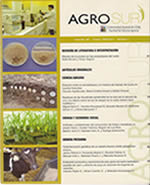The luminous environment and its influence on functional types of plants and herbage production in grasslands
Main Article Content
Abstract
Native grasslands have the ability to adapt to different levels of shade, an important feature that needs to be investigated since silvopastoral systems provide many ecosystem services and productive benefits. To analyze the effect of artificial shade on a natural grassland in the northeastern area of Uruguay, the accumulated herbage mass production, its seasonal distribution and botanical composition (i.e., functional groups) were evaluated. An experiment with a randomised complete block design with four replications was conducted for three years (from March 2019 to April 2022). The treatments were: native grassland (CN) in full sun, CN with 35% solar radiation interception (IRS), CN with 50% IRS, CN with 65% IRS, and CN with 80% IRS. The botanical composition in summer and autumn were similar throughout the years, and a summer perennial grasses domination was found which was independent of the level of solar radiation interception. In winter and spring, the botanical composition evolved towards a greater presence of winter perennial grasses, winter annual grasses, and Cyperaceae+Juncaceae+Liliaceae at the highest shade levels. Higher levels of solar radiation interception increased the production of the native grassland. The effect of shade over time determined differ nt seasonal responses in herbage mass production and composition of functional groups of plants

